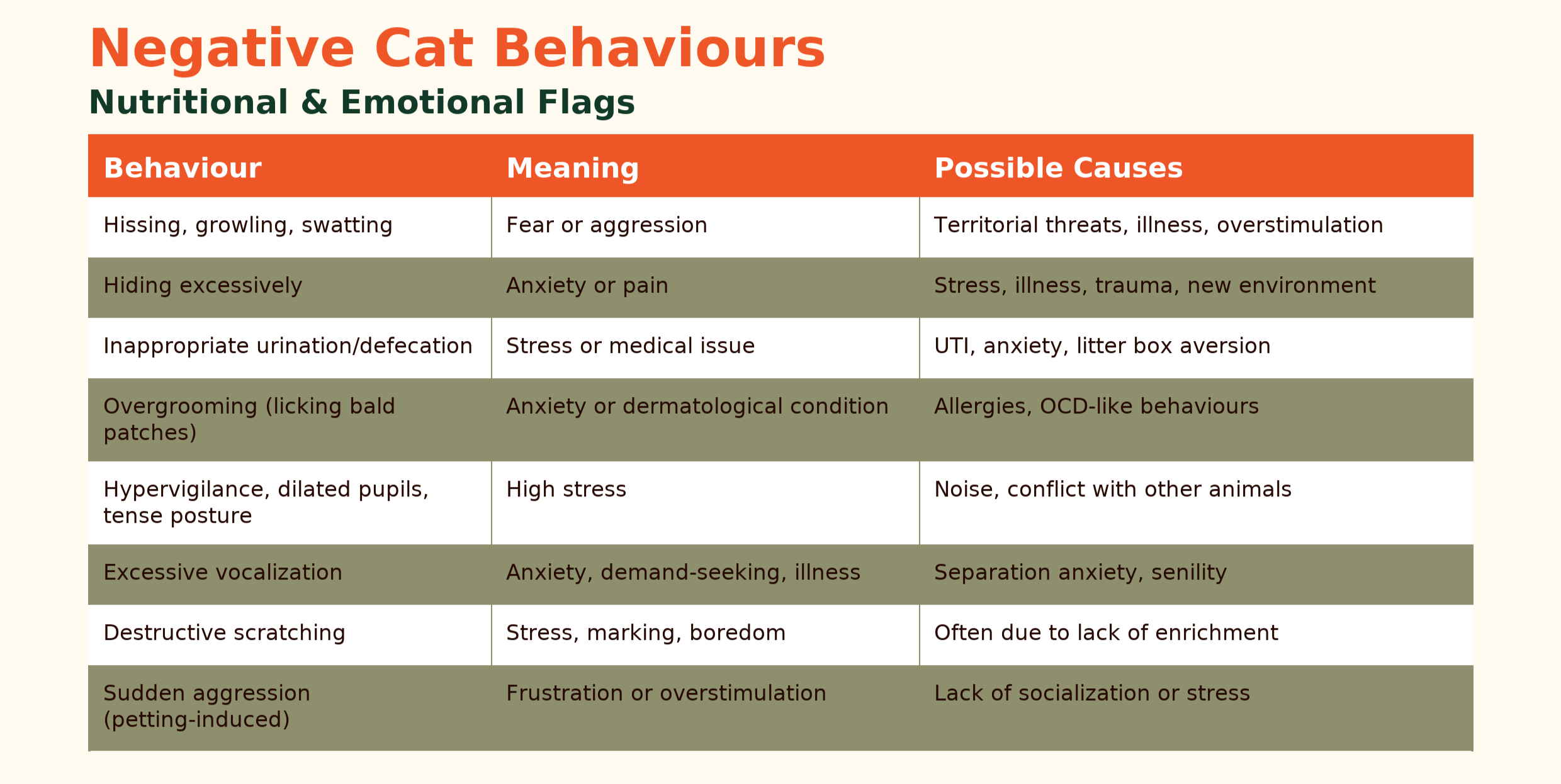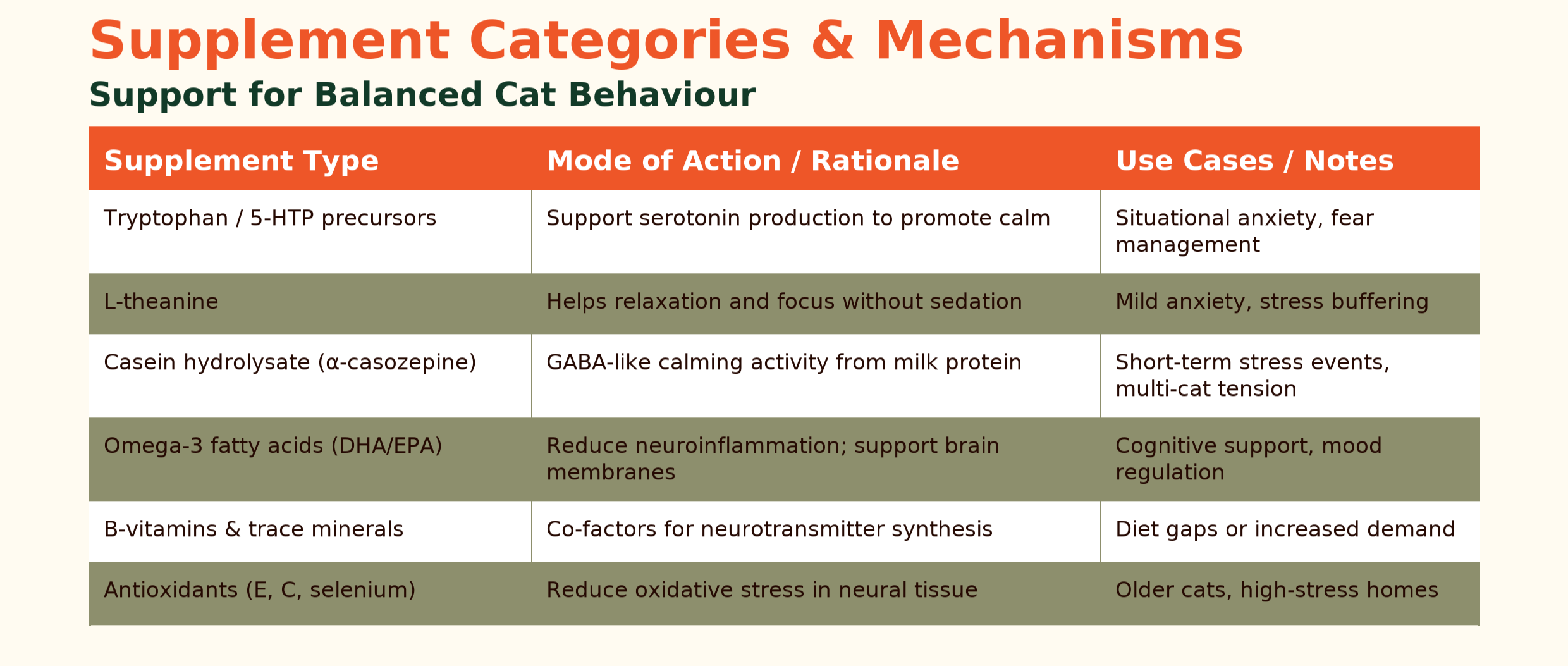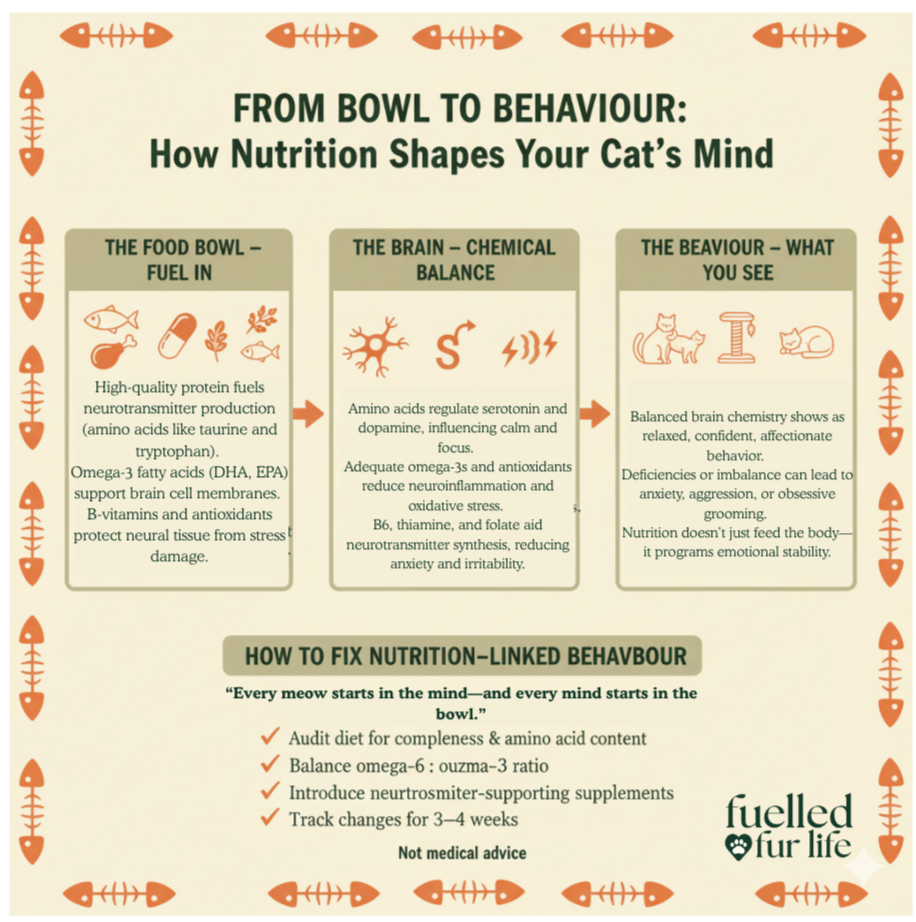Cat Behavior Decoded
By: Dr Francis Cabana (and not AI)
Understanding “Cat Behavior” (Yes, It’s a Thing)
If you’ve ever asked your cat, “Why are you staring at me like you’re judging my life choices?”—well, you’re not crazy. Our feline shadow-lords have a whole vocabulary of posture, vocalization, and micro-expressions (slow blinks, twitching tails, kneading fur) that mean something. That “something” often tells you about their emotional state, their comfort, and yep — sometimes about what’s in their food bowl.
In this post I’ll walk you through:
The positive cat behaviours you want to encourage (so you don’t feel like a hostage).
The negative / problematic behaviours (so you can decode them).
The role of nutrition (and occasional supplements) in modulating behaviour —when and how to intervene.
My recommended supplements — with disclaimers.
By the end, you should feel like a cat whisperer with a lab coat.
🟢 Positive Cat Behaviours (What You Actually Want to See)
When cats behave “well,” we often take it for granted. But each of these is a little data point that says: “Hey, this cat is coping pretty OK.”
These behaviours are usually signs of emotional and physical balance. They suggest your cat trusts the environment, feels safe, and has their needs reasonably met.
It’s worth remembering: cats are predators. They evolved to hunt small prey multiple times per day, not to sit around waiting for some giant kibble drop. Enriching feedings (foraging, small meals, puzzles) is a behavioural strategy too. PMC
🔴 Negative / Problematic Cat Behaviors (And What They May Be Signaling)
When a cat starts acting out — hiding, swatting, overgrooming, peeing in odd places — those are symptoms, not necessarily root causes. Think of them like the “check engine” light for your furball.
These behaviours are usually signs of emotional and physical imbalance. They suggest your cat’s environment, nutrition or social bonds could use some improvement to make them feel safe, happy and content
Nutrition & Cat Behavior: The Science You Should Know
I want to make one thing clear: nutrition is not a magic wand that fixes all behaviour problems. But it’s absolutely a modifiable lever. In some cases, suboptimal or deficient nutrition can amplify behavioural issues (anxiety, aggression, poor impulse control). In others, good nutrition can support behavioural interventions. For this reason, they are great to implement with relatively little effort as your first step.
Here are some of the key mechanisms and evidence:
Omega-3 Fatty Acids & Inflammation / Brain Health
Low levels of omega-3s (especially DHA) are correlated (in multiple species) with higher aggression, stress susceptibility, and cognitive decline.
A 2024 review of feline cognition discusses how nutrition (including fatty acid balance) is a promising but understudied area. MDPI
Omega-3s help regulate neuroinflammation and maintain membrane fluidity in the brain — which affects mood, impulse control, and cognitive resilience. EPA and DHA supplementation is NECESSARY if you are feeding kibble or canned food. If you are feeding a fresh, freeze dried or air-dried diet then there needs to be a natural source in the ingredients. If not, supplement.
Protein Balance & Amino Acid Effects
Cats are protein-driven animals. They typically aim to get ~50% of their energy from protein (on a dry matter basis) under many tested conditions. Frontiers
Too low protein may lead to lethargy, frustration, irritability. But diets excessively skewed in isolated amino acids (without balanced ratios) might cause metabolic or behavioral dysregulation.
Some classic behaviour-nutrition studies (e.g. Odendaal, 1997) showed that protein deficiency in early life might predispose to fear or aggression later. (You provided this reference.)
The takeaway: a complete, balanced, high-quality protein diet is foundational. So if your cat is on a weird home-made or imbalanced diet (or a food poorly formulated or low in protein), amino acid insufficiency could be part of the story.
Vitamins, Minerals & Antioxidants
Vitamins B6, thiamine (B1), B12, folate, and trace minerals are all critical to neural function, neurotransmitter synthesis, and mood regulation and GUESS WHAT! Once you open that bag of kibble, the B vitamins just start disappearing over time – OH and those B vitamins are essential for protein absorption. Are you starting to get the picture?
Deficiencies (or imbalanced intake) may contribute to irritability and anxiety.
Oxidative stress is a key villain: excess reactive oxygen species damage neurons, especially in brains (which have lots of lipids). Antioxidants like vitamins E, C, selenium, and trace minerals (zinc, copper) help mitigate these effects. Fresh food sources like berries and dark coloured vegetables (in small amounts) are also fantastic. Red seafood also has tons! Fan et al. (2023) showed dietary strategies for stress relief in cats (and dogs) focusing on antioxidant support. Source.
Thus: behavioral health = brain health = oxidative balance.
Aging, Cognitive Decline & Behavior Shift
As cats age, behavioral changes like increased vocalization, disorientation, irritability, sleep disruption, or house-soiling may emerge — often under the umbrella of cognitive dysfunction syndrome.
Supportive diets (with omega-3s, B-vitamins, antioxidants, choline) are used to delay or ameliorate these signs. Source.
Foraging, Meal Frequency, Enrichment & Behavior
Feeding style matters. Cats evolved to eat many small prey over the day. Feeding them once or twice a day may create frustration, boredom, or stress. Source.
“Food puzzles” and enrichment feeding help satisfy instinctual hunting/foraging drives, reducing stress and destructive behaviours. Read it here.
A good feline feeding program mimics natural behaviour: frequent small meals, multiple stations, puzzles. Source.
In short, behaviour and nutrition are deeply entangled. A behavior plan that ignores the bowl is like trying to solve insomnia by rearranging pillows.
When and How to Use Behavioral Supplements
Full disclaimer: supplements are adjuncts, not replacements for good diet, environment, or veterinary care. Feel free to discuss with your vet before starting any supplement, especially if your cat has medical conditions. But here are categories of supplements I love to use with my clients — with suggestions you can link to.
Remember supplements are great to fill in nutritional gaps - many of these nutrients can be (and should be) already present in your cat’s optimal diet.
Best Practices and Safety
Start with one supplement at a time, so you can monitor effects.
Use the lowest effective dose. More is not always better — especially with fat-soluble vitamins and minerals (which can accumulate).
Don’t use human formulations unless clearly safe — cats have unique metabolisms.
Monitor behaviour (e.g. via diaries) before and after supplement.
Again: supplements are supporting actors, not the star of your behaviour plan.
Integrating Behavior & Nutrition: A Step-by-Step Plan
Here’s a roadmap for applying this in a real cat:
Health Status: rule out pain, medical disease, UTI, GI issues, etc.
Behavioral observation / monitoring: baseline metrics (what times issues occur, triggers, contexts).
Diet audit:
Is the food optimized for the cat’s life stage?
Does the ingredient panel include good sources of taurine, protein, omega-3 (fish oil, krill, green lipped mussel), antioxidants, B-vitamins?
Could there be deficiencies (especially in home-cooked or exotic diets)?
Plug the gaps with a supplement, unless a whole new diet is needed
4. Feeding strategy optimization:
Break the daily ration into many small meals (mimic natural prey consumption) Source
Use food puzzles, elevated feeding stations, foraging enrichment Source
Spread feeding zones to reduce competition / stress
5. Behavioral enrichment and training: play sessions, interactive toys, environmental complexity.
6. Track progress: use logs or apps, look for incremental improvement or side effects.
Reiterate: sometimes you adjust diet, sometimes environment, sometimes supplement combination.
Over time — weeks to months — many cats show measurable reductions in stress, aggression, or obsessive grooming, especially when nutrition and environment are synergistically addressed. Not sure how to assess if this is working or not? Grab our FREE Cat Nutrition and Wellbeing Audit for your step by step checklist.
A Few Fun Notes on Cat Behavior (Because I Can’t Resist)
Cats are masters of slow communication. That tail flick? That flattened ear? That’s a haiku in feline. They expect you to be literate.
One weird, underappreciated trick: slow blinking back at your cat. It’s basically saying, “I see you, I trust you.” It can reduce tension.
I often tell clients: treat your house like a small cat civilization. Provide multiple “kingdoms” (cat trees, perches, hiding spots) so no one feels cornered.
If your cat stares at you blankly while you talk about your day—take it as a compliment. Keep talking.
What I Just Said About Cat Behavior….
Cat behavior is a rich language — full of nuance, context, and emotional data.
Many “bad behaviours” are signals, not punishments. If we misinterpret them, we do more harm than good.
Nutrition plays a crucial modulatory role. Deficiencies or imbalance can worsen behaviour, especially when the environment is suboptimal.
Supplements can help, but they are secondary to a complete diet, enrichment, and behaviour modification.
A strategic, holistic step by step plan gives you the best shot at sustainable behavioral improvement. Check out our FREE Cat Nutrition and Wellbeing Audit for you start optimizing your cat’s routine.





